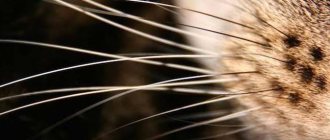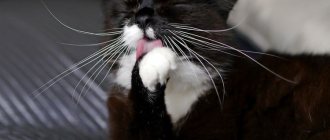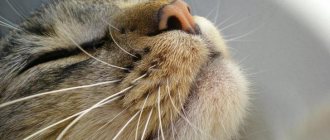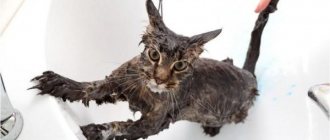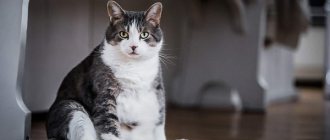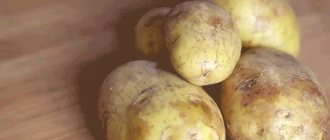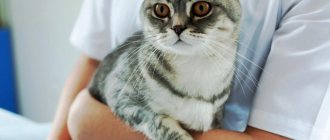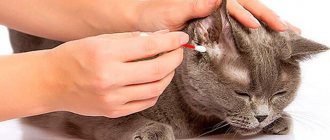Nutritional balance
What is the best way to feed a cat at home?
Veterinarians recommend choosing one of the options: ready-made food or self-prepared meals. Mixing them is strictly prohibited. When a pet's stomach consumes two options at the same time, it cannot secrete specific enzymes suitable for each type of food. As a result, the digestive system suffers and the immune system deteriorates. Experts recommend using ready-made industrial croquettes or pouches. These products spoil quickly, are expensive, and it is very difficult to calculate the balance of essential nutrients in them.
Natural or prepared food - a dilemma for many breeders
What do cats usually eat? Under natural conditions, they are predators; they obtain their main proteins, fats and carbohydrates from animal products. Porridge, vegetables, soups and other delights of the human table are not only useless for them, but also dangerous.
Important! A cat's stomach is not designed for salted, smoked, fried foods and spices. Attempts to give away half-eaten leftovers lead to a shortening of the pet’s life several times.
For your information! In addition to the desire to sterilize the animal, in order to get rid of the problem of constant marks and heartbreaking serenades, it is necessary to realistically assess the consequences of surgical intervention. Regardless of whether it is a purebred “British cat” or a street cat, the pet will automatically begin to overeat, get sick and spend a long time in a horizontal position.
Feeding a castrated cat must comply with special requirements.
Animals after surgery should eat according to different principles:
- Reducing portion sizes and calorie intake will be required. Addition to the main diet is strictly prohibited, even if the pet constantly asks for more food;
- you need to exclude from the menu foods with large amounts of magnesium, potassium and phosphorus;
- you will have to reduce the amount of fermented milk products;
- complete refusal of fish.
Important! Table salt is prohibited both after sterilization and for absolutely healthy individuals. Sodium chloride causes fluid retention in tissues, causing kidney pathology
Cats are characterized by a protein-fat metabolism, which should be taken into account when compiling their diet.
It should contain:
- At least 25% animal proteins. Veterinarians do not set an upper limit, since cats are naturally carnivorous and are not susceptible to protein poisoning. When creating a diet, you should separate animal and plant proteins, since cats need the former.
- 5-20% fat. If it is not possible to satisfy the daily requirement with simple food, you can give the animal butter or vegetable (corn, olive, flaxseed) oil or fish oil in small (0.5 tsp per day) quantities.
- Up to 10% carbohydrates. The cat's body does not absorb them well, so the amount is kept to a minimum. The carbohydrate component (cereals, vegetables) is left as a source of fiber.
In addition to proteins, fats and carbohydrates, a cat’s diet should contain minerals, amino acids (there are 22 of them in the animal’s body, of which only 12 are independently replenished), vitamins A, D, E, K, etc.
To ensure their intake into the body, your pet can be given bran, dried kelp, fresh grass, and sprouted grains. If desired, they can be replaced with special vitamin supplements, but you should consult a veterinarian before taking them.
When choosing a diet, it is worth considering the balance of calcium and phosphorus. Normally, it is 1.2-1.3 to 1. Since muscle meat contains a lot of phosphorus, but almost no calcium, the balance is often upset, which leads to health problems.
Giving your pet bird or fish bones is prohibited. You also cannot boil them - then the structure of calcium changes and it will not be able to enter the animal’s body.
Natural food or dry food
There is a heated debate among cat lovers about what is better: natural food or ready-made crackers. Adherents of both camps find reasons for and against their views.
| Ready-made medicinal food | Natural nutrition |
| + more convenient to use, + easier to measure portions, + does not spoil for a long time, + no need to cook. | + the composition is precisely known, + always fresh food, + it is possible to exclude or add certain ingredients according to the cat’s taste. |
| — errors in the composition are possible (inconsistencies with the information on the packaging), - protein content cannot be precisely controlled, - difficult selection. | - it is difficult to maintain a balance of nutrients, - regular purchase of products, - waste of time on preparation. |
It is important to remember that your doctor should have the final say. Only he has sufficient education and data from all animal studies to prescribe a competent diet.
In practice, most veterinary specialists recommend ready-made food, since it is rare that an owner has enough time and patience to regularly prepare food for their pet from natural products. It’s easier to buy a ready-made dryer that already has everything you need.
If the pet refuses to eat, then with the permission of the veterinarian you need to change the food or the selected diet.
It happens that a cat does not like a low-protein diet. The most capricious individuals may even “go on a hunger strike” - as a matter of principle, they will not eat anything new. For some time this is not difficult for them, since their appetite is still reduced. In most cases, allowing a dog to starve is more harmful than allowing a stubborn furry to eat its usual food.
Normal protein intake for chronic renal failure is not as bad as an excess of phosphorus.
Eating high-fat foods is a good way to provide energy for your furry pet without increasing phosphorus levels. However, a diet rich in fat is not suitable for animals with pancreatic diseases. In such cases, you need to choose cat food that is low in protein and fat.
Daily food intake for cats
During the day, an adult cat eats a volume of food corresponding to 3-7% of its body weight. For kittens the figure is higher - 9-10%. The daily norm is divided into several meals, since the animal needs time to digest it and absorb nutrients. Adult animals eat 2-3 times a day, kittens - 6-8, depending on age.
The exception is pregnant and lactating females: they are not limited in food. Spayed or neutered animals are fed less because they are less active and prone to obesity.
Feeding standards
Manufacturers divide biscuits into several classes: economy, premium, super-premium. They vary in price and quality.
Economy class includes Whiskas, Kitiket, Friskas and Felix. They are distinguished by their low price and bright, memorable packaging. They contain all the vitamins, minerals and proteins necessary for cats, but for their production the manufacturer uses low-quality raw materials. The source of protein in them is not meat products and offal, but cereal plants and bone meal. They contain flavoring additives that are addictive to animals.
Note! An inexpensive representative of the economy class provokes urolithiasis, gastritis, problems with the functioning of the kidneys and digestive tract. Premium and super-premium varieties contain meat proteins, essential amino acids, carbohydrates and antioxidants
A balanced menu should contain at least 30% animal products, and only oats and rice from plant components. Amino acids and antioxidants are also included. Wheat and corn are useless fillers
Premium and super-premium varieties contain meat proteins, essential amino acids, carbohydrates and antioxidants. A balanced menu should contain at least 30% animal products, and only oats and rice from plant components. Amino acids and antioxidants are also included. Wheat and corn are useless fillers.
Good lines are presented:
- American or Dutch Hills or Iams;
- English Arden Grange;
- Canadian 1st Choice or Orijen;
- German Leonardo;
- Russian Blitz;
- French Profine Adult Cat;
- French, not domestic Royal Canin;
- Czech Fitmin For Life.
For your information! Not all of the listed products have become famous in the Russian Federation. Some of them can only be ordered on supplier pages.
Protein is an essential element of cat nutrition.
Protein is an essential nutrient, a chronic deficiency of which can lead to irreversible health problems for your pet. This is the main building material for the body, a source of energy. Proteins are composed of amino acids, most of them are essential (taurine, histidine, methionine, arginine, valine, leucine, lysine, tryptophan, isoleucine, phenylalanine, threonine). They are not synthesized from other substances, so they must come from food.
The main food for predators is provided by animal protein, which contains the entire set of amino acids that cannot be reproduced by the body. It is impossible to completely replace meat with protein-containing plant products (for example, legumes). Cats will not get all the nutrients they need from them.
It is especially important for kittens, pregnant and lactating cats to comply with the physiological norm of animal protein consumption. A significant reduction in the protein diet provokes growth cessation, loss of body weight up to critical, fragility, and brittle bones.
Diet for urolithiasis
For urolithiasis, veterinarians advise using special industrial feeds designed to combat the disease. If it is not possible to purchase high-quality canned food and biscuits, then you can switch to natural products.
Products that contain:
- oxalic acid;
- flavorings and aromas;
- potassium and salt.
Note! With increased amounts of calcium, the pathology can progress. The base should include boiled lean meat
When feeding an animal with KSD, you must adhere to the following requirements:
The base should include boiled lean meat. When feeding an animal with KSD, you must adhere to the following requirements:
- the amount of fermented milk products is reduced by 2 times;
- Chicken and quail eggs are removed from the menu;
- Among vegetables, preference is given to beets, pumpkins, carrots and Brussels sprouts.
Important! Urolithiasis is incompatible with meat broths and offal. The latter contains oxalic acid and purines
What is veterinary food
Veterinary food is a special dietary food, the formulation of which is developed taking into account the special needs of unhealthy animals. Differences from standard diets depend on the type of disease. For example, rehabilitation foods are higher in calories, contain easily digestible ingredients and have a delicate texture. This allows you to reduce the load on the gastrointestinal tract and prevent injury to neighboring tissues after surgery. In addition, such dietary nutrition prevents exhaustion and provides the animal's body with energy and fluid. This is especially important if the pet is weakened, under stress, or eats little food due to being picky.
Sample menu for the week
The approximate menu for the week is compiled individually. When choosing products, the animal’s weight, breed, and activity are taken into account.
Recipe for a balanced natural diet:
- turkey fillet - 1 kg;
- chicken hearts - 0.5 kg;
- beef tripe - 0.5 kg;
- chicken necks - 0.2 kg;
- grated vegetables (carrots, pumpkin) - 0.25 kg;
- dried kelp or bran - 1 tsp.
All meat ingredients are cut into medium pieces, mixed with vegetables and frozen, thus eliminating the need to cook every day.
Laminaria or bran is sprinkled on the food immediately before feeding the cat. The menu is suitable for animals weighing 3.5-4 kg. The diet is good for cats of all breeds, including finicky Burmese or Persian.
Despite the obvious differences (and even frequent psychological incompatibility) between dogs and cats, the main principles of feeding both remain unchanged and common to both “races” of pets. But about the differences - in more detail.
If canines are both carnivores, herbivores and scavengers, then cats - domestic and wild - are almost pure predators. Cats are not omnivores, and even less adapted than dogs are to eating all kinds of cereals, pasta and everything else that their owners can think of (not to mention ready-made food). Dr. Ian Billinghurst calls cats “reluctant carnivores,” pointing out that their digestive system and the entire body as a whole are built in such a way as to function precisely on food of animal origin. In addition, cats are created to obtain almost all the moisture (water) necessary for the body from food; they rarely drink (which makes feeding them dry food completely inadequate). Therefore, the “menu” of cats should primarily consist of frames of small mammals (I think it is unlikely that these will be laboratory mice and rats, but at least you can focus on various poultry, rabbits, etc.).
Expressed in terms of nutrition, a cat's diet, compared to a dog's, should contain much more animal proteins and fats and much less plant products , incl. and vegetable fats and oils. A cat needs slightly less bones than a dog, and more of all kinds of offal, especially liver.
Since a cat's diet should consist almost entirely of animal products, the task of a cat owner is simplified compared to those trying to maintain a BARF diet for their dogs. But switching a cat to this natural diet is a real hassle. That's why it's better to start feeding your cat natural products from an early age.
The main components of the BARF menu for cats are the same as for dogs, but the proportions here are different:
75% - meat and meat bones 15-25% - offal (liver, heart, stomachs) 0-5% - ground vegetables The rest - additives and vitamins
Meat bones . Unlike dogs, cat meat bones should be meatier. If for an adult dog the content of meat and bones in a meat bone should be approximately 1:1, then cats should have twice as much meat, i.e. meat and bones should be in a 2:1 ratio, respectively. This proportion can be achieved either by selecting special meat bones, or by adding pure chopped meat to the meat bones. The most convenient option for meat bones for cats are carcasses of chickens and other poultry (backs, breasts, necks).
Offal. With this ingredient in the cat's diet, everything is very clear. Unlike dogs, cats need a slightly larger variety of internal organs, which they would eat first if they had the opportunity to hunt small animals on their own. Liver, heart, gizzards (unpeeled chicken, for example, are also suitable) - this is the main set that should be given.
Vegetables . For cats, vegetables must be ground, achieving a consistency similar to that found in the stomachs of small animals that cats feed on. Vegetables are mostly green (not by ripeness, of course, but by color: leafy vegetables, cabbage, cucumbers, etc.) and not starchy (that is, potatoes disappear immediately and forever). All vegetables and fruits selected for your cat should have a low glycemic index. Remember that vegetables play a much smaller role in a cat's life than in dogs.
Supplements and vitamins . The cat is given the same vitamins, fatty acids, etc., as the dog. The principles for calculating dosages of vitamins and minerals for cats are the same as for dogs - see the corresponding table. The only important difference is the source of essential fatty acids. The fact is that cats do not have a mechanism for converting inactive forms of these acids into active ones, so it is vitally important to provide cats with sources of essential fatty acids that contain them in their active form. Moreover, all these sources must be of animal and not plant origin. Raw meat, especially red raw meat, and eggs are good sources of the active form of Omega-6 for your cat. And cod liver oil and salmon oil are excellent sources of Omega-3. In case of inflammatory diseases (joints, or colds or infectious diseases), the recommended dosage of fish oil for a cat is from 1/2 to 1 teaspoon per 4.5 kg of cat’s weight, salmon oil is also from 1/2 to 1 teaspoon spoons per 4.5 kg of weight. When switching to a natural diet, a course of probiotics and enzymes is required (about switching to BARF, read the “dog” article, adjusted for the above proportions and cat characteristics).
I will not dwell separately on the principle of transferring a cat to BARF. I do this for several reasons. First of all, I don’t have a cat, and I can’t even imagine how she might react to an offer to try a completely new food. Secondly, I outlined in such detail the principles of translation, possible concerns, pitfalls, etc. in the article “BARF for Beginners”, I don’t see the point in repeating all this here. Everything that is written there is equally true for cats.
Below I present an approximate weekly menu for a cat (how convenient, right?), which is published in Ian Billinghurst’s book “BARF Diet for Dogs and Cats.” Remember. That this is just one of hundreds of options that you yourself will be able to compile and use over time in your long joint human-cat life ;o)
Monday Morning: raw meat bones - chicken wings or necks Evening: Twisted beef in a meat grinder with ground vegetables and egg. Additives: fish oil (can be added directly to vegetables), kelp (seaweed), alfalfa and B complex vitamins.
Tuesday: Morning: Raw meat bones Evening: Chopped liver and heart with ground vegetables. Additives: kelp, alfalfa, vitamin E
Wednesday: Morning: Raw meat bones (wings and necks) or twisted chicken backs Evening: Twisted beef (medium fat, not lean) with egg and ground vegetables.
Thursday: Morning: Twisted lamb, pork neck or veal tail Evening: Raw fresh fish. Additives: fish oil, vitamin E, kelp.
Friday: Morning: A piece of rabbit (for example, back, breast) - can be ground in a meat grinder. Evening: Raw meat bones with pieces of heart and kidneys, and ground vegetables. Supplements: fish oil and vitamin E.
Saturday: Morning: Raw meat bones - chicken wings or necks. Evening: Twisted turkey meat with added egg. Additives: vitamin E and fish oil.
Sunday: Morning: Twisted lamb, pork neck or veal tail, with some ground vegetables added. Evening: Large chunks of beef for chewing.
A few comments on the above example menu: 1) This menu is just an option that should help you understand the idea of BARF feeding your cat. What exactly, at what time of day, and on what days of the week you will feed your cat is up to you. By the way, the menu does not include live bio-yogurt, which can actually be given from time to time by adding to vegetables. 2) The menu shows different types of raw meat bones, which the cat is fed on different days throughout the week. You can choose another option - mix different types of meat bones and give them in this mix every day. The third option is that you can feed one source of bone meat for a week, and then the next for a week, and so on. For example, this week you feed your cat only chicken, the next week only beef, the third week pork, etc. Feeding raw fish does not have to be limited to one day a week if your cat loves fish. Although fish should not be the main thing on the cat's menu. Don’t try to complicate your task if you don’t have beef today, and yesterday you already fed the cat chicken - feed it again today with chicken, and if necessary, tomorrow, and then you can feed it beef for the same number of days in a row. Start from what is available to you and remember that nutritional balance is achieved not in one feeding, not in one day, or even in a week - but over several weeks. 3) This menu does not include a “fasting day”, however, if it is necessary, you can fast your cat from time to time. The benefits of fasting for animals are written in a separate article (it is addressed to dog owners, but its content is exactly the same for cats). 4) You can feed your cat a “multi-mix” , preparing it for a week in advance. Here's how it's done:
Multi-mix for cats consists of:
70-75% raw meat bones 15-20% offal 10% other additives 0-5% vegetables and fruits.
Ingredient #1: Raw meat bones. 3.4 kg of raw meat bones, well minced in a meat grinder: - chicken frames, necks and wings, - lamb ribs or beef ribs, - any other meat with bones that you have Meat and bones can come from different animals, for example, turkey meat, and rabbit or lamb bones. If your cat is not allergic to any meat products, then do not be afraid to mix: the more varied the mix from different sources of meat and bones, the better. Or you can make mono-mixes - so that each week there is some kind of source of meat and bones, but in different weeks - different sources, for example - chicken this week, beef the next, then turkey, etc. d. Remember that maso and bones should be in a 2:1 ratio for a cat (2 parts meat - 1 part bones). Remember also that cats require fattier meat than dogs. This is especially true for young, active, pregnant and lactating cats. Of course, if your cat is a little fat, then it is better to give meat that is not very fatty, so as not to provoke further weight gain.
Ingredient No. 2: By-products. 680 g finely chopped or ground liver, kidneys, hearts and gizzards. Remember that all these “spare parts” must be bought from trusted places and be clean (free from parasites) - as a rule, when you buy raw livers and so on, it’s already clear from their appearance how healthy they are.
Ingredient #3: Other additives. 3 whole eggs, including shells (washed, of course) 43 g salmon oil 114 N live yoghurt or, instead, an equivalent amount of probiotics 57 g kelp powder (seaweed can be bought in powder form at any pharmacy) 28 g fresh ground garlic (optional if your cat is put off by the smell).
The ingredients listed serve a variety of cat needs. Depending on the circumstances and health of the cat, you can add fish oil, vitamins E, A, C and B, etc. to this.
Ingredient No. 4: Vegetables and fruits. 170 g of various ground vegetables and fruits. Which ones exactly - this was discussed above in this article and in many other articles about natural feeding published on this site.
Cooking method: 1) Twist raw meat bones and egg shells; 2) Grind the vegetables and fruits in a food processor, then add the eggs and mix well there (in the food processor); 3) Finely chop or twist the offal; 4) Find a large enough bowl, put all the ground and twisted ingredients there, add the remaining ones (vitamins, etc.) and mix everything thoroughly until a homogeneous mass is obtained. It is very important that your cat eats everything you put in the mix, so you need to achieve a homogeneous mixture - one from which she cannot take out what she likes best. 5) Divide the resulting multi-mix into portions, put what you need now in a bowl, put what you need for the next feeding in the refrigerator, and put the rest in portions into containers or bags (as convenient for you) and freeze. The main thing is not to forget to defrost the next portion in time. 6) Various additives, such as eggs, fish oil, vitamins, etc., can be added not during the preparation of the mix, but in each portion - before giving it to the cat. 7) You can feed this mix every day - both morning and evening, or you can feed it only in the morning, and raw meat bones in the evening, or vice versa.
How much to feed? The amount of food received per day usually varies between 5-10% of the cat's weight. This daily requirement is divided into several small portions, which are given to the cat several times a day. Young, growing cats need more food (their daily requirement is closer to 10% of their body weight). Older cats should usually receive less - about 5% of their body weight. In the wild, cats, being hunters of small prey (birds, rodents, insects, lizards, etc.), spend their days eating little but often. In other words, even an adult cat would prefer to be fed small meals 4-5 times a day. This does not mean that every cat owner must feed the cat continuously, but some cats do require such frequent small feedings. Billinghurst advises adapting your cat to 2-3 meals a day, believing that this will be quite adequate for an adult cat. Let's assume that you have an adult cat of average activity and normal weight for its breed and bone structure (neither thin nor fat). Then the amount of food she should eat on average per day is 7.5% of her body weight. Here's how much it will be in terms of grams:
| Cat weight | Daily food intake |
| 2 kg | 150 g |
| 3 kg | 225 g |
| 4 kg | 300 g |
| 5 kg | 375 g |
| 6 kg | 450 g |
Of course, these are approximate dosages, because... All cats differ from each other in needs, activity, age, health, etc. The main thing is not to overfeed your cat or make her starve (unnecessarily). Many older cats only need 3-5% of their body weight (i.e. an older cat weighing 4 kg can easily get by with 120-200g of food per day). Likewise, spayed cats (neutered cats) require less food because... they gain weight more easily. Small cats generally require more food (as a percentage of body weight) than large cats. For example, a young active cat whose weight is 2 kg can eat up to 200 g of food per day (10% of body weight), while a ten-kilogram cat will be content with 500 g per day (5% of body weight). A small kitten should eat up to 10% of its body weight per day. If the kitten is less than 3 months old, it should be fed 4-5 times a day. From 3-6 months - 3-4 times a day, and after 6 months - according to the scheme for an adult cat, i.e. 2-3 times a day. The principles of feeding a baby are practically no different from how and what it is recommended to feed adults. However, if the kitten came into your home before 8 weeks of age, it is worth adding the so-called. "milkshake" . Here is his recipe:
1 cup (250 ml) whole milk 2 egg yolks 2 dessert spoons (30 ml) cream 2 dessert spoons (30 ml) whole organic yogurt without additives (i.e. without sugar, fruit, etc.), bio yogurt must contain high percentage of living bacteria. All ingredients are mixed in a mixer or blender (you can, of course, manually).
This cocktail is especially suitable for very young kittens who still have difficulty coping with solid food. For very small kittens, it is good to add digestive pancreatic enzymes in powder form to this cocktail (see the instructions for the dosage). Add this powder to the shake 10-15 minutes before feeding so that the enzymes can already begin their work. This will help to properly establish the baby’s still unstable digestive system.
Of course, the volume of the daily portion for a cat of any age also depends on the calorie content of the food given. The fewer calories, the larger the daily portion can be. Multi-mix is lower in calories than fatty meat bones and pure meat.
In conclusion, transitioning a cat to BARF (or any other diet) is likely to be difficult - at least according to Ian Billinghurst. For this reason, he recommends a “slow” method of transferring to this diet, which is based on the fact that first all the ingredients are given boiled (don’t be alarmed - that’s exactly it); as a rule, a homogeneous mix is made of ground meat bones, offal and vegetables with adding an egg. Then, gradually, raw ground ingredients are added there (i.e., part of the prepared mix is boiled, and part remains raw) - and so on until the raw completely replaces the cooked. Of course, first you can try to switch your cat to a natural diet right away - by offering her the menu indicated above. However, if she refuses to eat “it,” then proceed to a smooth translation. Remember that probiotics must be given throughout the transfer to avoid digestive problems. Good luck.
based on materials from the book Dr. Ian Billinghurst "The BARF DIET: Raw Feeding For Dogs and Cats Using Evolutionary Principles" 2001
The most important features of cat digestion
Cats are absolute predators. According to various studies, from 90 to 95% of their diet is meat. Accordingly, recipes for natural food for cats should mostly consist of meat and offal, and low-fat ones. The share of plant foods should not exceed 10%.
The basis of a cat's diet in natural conditions: small rodents and reptiles, some insects, small birds. The animal eats its prey entirely: with fur, feathers, and sometimes with teeth and claws. Yes, the above parts of the victim are of little nutritional value and for the most part are not digested. However, nature is very prudent: some compounds that make up the bones “go to work.” Therefore, your pet’s diet must include bones or special calcium supplements. As for eggs, quail eggs are best.
The need for a significant amount of cereals and vegetables in a cat’s diet is a myth. The animal takes all the necessary nutrients, and primarily vitamins, from raw meat, and not from fresh carrots or cabbage.
Together with a mouse or bird, the cat receives a very small amount of grains. Therefore, you can include a little oats or buckwheat cooked in water in your diet. Legumes and corn cannot be offered - the animal’s body will not digest them, and at the end you will get completely intact grains and loose stool. Plus the pet’s poor health.
About milk. Most adult cats do not have the enzyme lactase, which is necessary to digest milk sugar. But some cats tolerate milk well, and you can give your pet a little lukewarm milk from time to time. Fermented milk products are healthy and can be given once or twice a week. But not every cat will agree to eat fermented baked milk or cottage cheese.
Although there is an opinion that the main product for cats is beef, this is not entirely true. After all, in nature, murkas are deprived of the opportunity to feast on even a calf. Still, the best (but far from the only) product for feeding a cat is chicken heads without beaks. For the convenience of the animal, they can be cut in half. Chicken necks without skin and fat, cut into pieces or crushed with a hammer, are also excellent. Other parts of the chicken carcass need to be cleaned of bones; your pet will not be able to chew them and will be injured!
Most of the diet should be raw foods. Raw meat contains all the necessary vitamins. To destroy possible pathogenic bacteria, it is necessary to freeze the prepared portions for at least three days at a temperature no higher than -18⁰. The exception is sea fish, which must be boiled and separated from bones for disinfection. A fish dish should appear on a cat’s table no more than once every five days. It is not recommended to feed river fish.
All food should be at room temperature
However, the animal will not eat food that is either too hot or too cold.
In addition to the above products, the following are suitable for a cat's diet: lean beef and lamb, rabbit meat, turkey, chicken and turkey stomachs, hearts (this is one of the best sources of taurine, a very important substance that is not synthesized in the animal's body), liver in small quantities. You can mix carrots, beets, cabbage, pumpkin, and zucchini into your food.
But: the brighter the vegetable, the more noticeable it affects the color. Blue cat coats are especially affected, becoming dirty-rusty in color.
Any smoked, salty and fatty foods (for example, pork, butter), sweets, fruits and dried fruits, bread, potatoes, onions, garlic, and spices are harmful to cats.
The statement “an animal senses what is harmful and what is useful” is a myth. Many cats enjoy eating cakes or dried fish. The same myth is that an animal always knows when to eat.
To cleanse the stomach of fur, your cat needs to regularly eat fresh grass. Sprouting oats at home is as easy as shelling pears.
How much food do you need per day to keep your pet in good health? For an adult animal: approximately 50 g per 1 kg of body weight. An older cat needs to cut back on its diet a little to avoid obesity. It is advisable to feed twice a day, morning and night.
Follow strict feeding times
about.gitlab.com
If we take the issue broadly, then obesity in any animal - from hamsters to cats and further to humans - occurs according to a simple formula:
An increase or decrease in body fat with a sedentary lifestyle corresponds to the difference between the number of calories in and calories burned.
see also
25 Photos of Cats You'll Have to Look Closely at (Some You May Have to Look Twice)
In other words, if a cat takes in more calories from food portions than it expends in its activity, it will gain weight. This means that, first of all, to lose weight you need to take care of reducing your calorie intake.
Structuring your meals will help with this issue. So, for example, if there are several cats in the house, you need to delimit their meals both in time and geographically.
For example, your cats will eat in different rooms or at different times in an environment that prevents another cat from entering the “dining room” at that time.
This can be achieved in such a way that one cat will eat in the bedroom (you can also use other rooms in the apartment, the main thing is that they are isolated, so the corridor is not very suitable), and the other in the kitchen.
see also
7 Signs Your Cat Is Nervous: What Science Says
If your home is small in size or, say, you live in a studio, you can follow the following strategy:
- close the door when it’s time to feed one cat;
- you don’t pay attention to the protests of the second pet, who attracts your attention so that you let him into the “dining room”;
- remove the second pet's food bowl.
It is important to create a physical separation that will prevent them from eating each other's food.
Features of feeding cats at different ages
The daily amount depends on:
- from age;
- health conditions;
- body weight;
- cat breed.
Before the first six months of life, cats require larger volumes for normal development than sexually mature pets. Babies are fed up to 4 times a day in minimal portions.
For cats older than 6 months, the daily dose is divided into three times, for mature animals - into 1-2 doses. Older pets gradually lose their appetite; this problem is associated with slow metabolism and tooth loss. Cats over 7 years old require one meal a day.
https://www.youtube.com/watch?v=HULaujGmICA
Young animals are fed depending on age:
- from week 5, the special mixture is replaced with goat’s milk and boiled quail yolk;
- at this time, fermented milk products and meat puree mixed with liquid porridge are introduced;
- after 2 months they are accustomed to adult food.
Babies have their own dietary requirements:
- the beef is boiled and crushed to a paste-like mass or given finely chopped. It should make up half of the daily diet;
- chicken or turkey replace beef up to 3 times a week;
- After boiling, the lungs, chicken liver or heart are finely chopped. Can be included in the menu no more than 2 times a week;
- puree from carrots, pumpkin, zucchini or beets is made from boiled vegetables processed in a blender. Puree can be mixed with any of the meat products. Vegetables should make up no more than 10% of the daily value;
- fermented milk products - cottage cheese, kefir or fermented baked milk with minimal fat content - are given daily.
Important! Children are not allowed to include fish in their diet. Additionally, multivitamin complexes are administered
For the youngest, the first feeding is carried out through a syringe.
The kitten is fed 4-5 times a day
They start feeding the animals with soft meat purees, then gradually switch to minced meat. From 2 months you can give kittens meat cut into small pieces. The body of young predators also absorbs dairy products well: cottage cheese, kefir.
Young animals are fed more often than adults. At 1 month, food is given 6-7 times a day, at 2 - 5-6, at 3 - 4-5. They must have access to clean drinking water at all times.
Some more tips for switching to a cat diet
Guidelines for offering food.
How you provide your cat with food can also be an important factor when switching to a cat diet. We will give you some tips on this matter:
- Offer food in several portions throughout the day instead of just one.
- Choose methods that delay eating. For example, using toys to hide food or feeding a diet with larger grains.
- Do not give your pet leftover food.
- Weigh the food on a scale before offering it to your cat.
Does diet work for cats? What should be the rate of weight loss?
By reducing the daily portion, choosing a high-quality diet and encouraging the animal to exercise, the mentor can watch the cat gradually lose weight.
Many cat food brands have specialized lines for obese cats that reduce the fat and energy content of the food and add supplements such as L-carnitine to help the cat lose weight.
In addition, these diets also increase the amount of fiber in the diet, which can be increased by up to 15% to increase the volume of food and thus make your cat feel full faster.
If the diet works, the animal is expected to lose 5% per month. The pace is usually slow but continuous.
Encourage your cat to move.
To make your cat's diet more effective, encourage her to move. Take time to play with it. For example, you can awaken your hunting instinct with a variety of different toys or enrich the environment with a scratching post of varying heights.
To begin regular play activity, it is best to start with short sessions of two to three minutes and increase the time as you lose weight, as well as the intensity of the exercise.
These are the basic steps when starting a cat diet , but it's important to be consistent and monitor your pet's weight to make sure it's working. In short, obesity predisposes you to many different diseases and is always best avoided.
Can rabbits eat bread? baking? buns?
Causes of jaundice in dogs: symptoms and how to treat the disease
What are hybrid animals? Liger, Mice and their behavior
Rabbits and Spinach: 4 Things to Remember Before Feeding
Benefits and properties of goat milk for dogs
Benefits of Salmon Oil for a Dog's Diet
Food outside the bowl: why does a dog do this?
The Importance of Antioxidants in Dog Food
Are candies dangerous for dogs?
What products are prohibited
The list of permitted foods includes:
- Various types of meat and poultry (beef, veal, lamb, rabbit, chicken, turkey). You can feed the animal with day-old chicks and feed mice sold in pet stores.
- By-products (liver - except pork, chicken hearts or stomachs, kidneys, beef tripe, lungs) contain vitamins and microelements that are not found in plain meat, and therefore are considered an essential part of the diet. They are given in small quantities, otherwise the animal may have problems with stool.
- Fermented milk products (cottage cheese, kefir, yogurt, unsweetened yoghurts without additives). Fat content should be no more than 5%.
- Vegetables (zucchini, lettuce, carrots, pumpkin, greens, broccoli, cauliflower) can be given raw, boiled or steamed. If the animal does not like the taste of vegetables, they are ground into puree and mixed with the meat component.
- Eggs can be given raw or boiled. Only the yolk of chicken eggs is useful to a cat, but quail eggs can be given whole.
- Fish (only sea fish, low-fat varieties, boiled). You can supplement it with seafood - shrimp, cod liver.
Other food supplements (eggs, fish, etc.) are given in small quantities as treats. It is not recommended to feed your cat more than 1-2 times a week.
Prohibited foods for cats:
- onion and garlic;
- whole milk, cheeses, sour cream, fatty dairy products;
- eggplant;
- tomatoes;
- legumes;
- Solanaceae;
- any canned and pickled foods;
- potato;
- fried food;
- food with hot seasonings, spices, salt;
- chocolate;
- sweets;
- flour products;
- mushrooms;
- White cabbage;
- beet;
- hot peppers;
- River fish;
- coffee, alcohol;
- meat and poultry of fatty varieties - pork, duck, lamb.
Don't feed your cat from the table
This is one of the most common mistakes made by cat owners. Food for cats and dogs is not very suitable for humans, is it? The enzyme system of animals cannot always cope with the foods that people eat. Under no circumstances should cats be given pork, milk, liver, bones, boiled potatoes, legumes, fatty fish, or mushrooms. Eating these foods can cause a number of health problems in your cat, from digestive diseases to disorders of the cardiovascular system.
Natural cat food recipes
The desire to switch your pet to a healthy diet raises the question of how to feed the cat. The transition takes place in stages with the replacement of some of the usual cat food with a new one.
Of chicken eggs, only boiled yolks are suitable for cat food. They are given to sexually mature individuals several times a week.
How to properly feed cats vegetables? They are given raw and boiled. To enrich the diet use:
- cauliflower;
- zucchini;
- carrot;
- pumpkin;
- green beans.
Note! Vegetables can be mixed with meat dishes or chicken egg yolk
What cats eat with pleasure is sea fish. It is boiled or frozen, cleaned of fins, bones, and skin. You can feed your pet with it only twice a week.
Some cat owners prefer to serve their four-legged salmon with rice:
- steam 150 g of fish;
- boil 1/3 cup rice;
- take ½ hard-boiled egg;
- All components are thoroughly mixed.
They add a vitamin-mineral complex and calcium carbonate (1 tablet each). After stirring again, serve to the cat.
Important! Self-prepared food does not meet the animal’s body’s needs for vitamins and minerals. During cooking, you need to add multivitamin complexes to them.
When feeding cats, it is prohibited to use fatty, harmful and irritating products to the gastrointestinal mucosa. They should not be given:
- pork, lard;
- lamb, duck, goose;
- store-bought minced meat;
- bones, river and fatty varieties of sea fish;
- garlic, all types of citrus fruits;
- grapes, beans, soybeans;
- onions, peas, avocado;
- sausage, fatty and smoked products;
- sugar, chocolate, sweets;
- baked goods, table salt.
Important! Violation of nutritional rules can lead to the development of urolithiasis, cystitis, pancreatitis, renal failure, poisoning
When is low protein food needed?
If lots of protein is good, then why buy low protein cat food? The diet may be required for medicinal purposes: for serious kidney diseases, for example, chronic renal failure (CRF) and a number of other problems. Older, sedentary pets may also be advised to reduce their protein intake. For healthy, young, active animals, restrictions are not only unnecessary, but even harmful.
If a cat does not have kidney problems, then to maintain good health it should receive its daily protein intake (5 - 6 g).
The topic of proper nutrition for pets is complex and extensive. Because of this, confusion often arises. In order not to become a hostage to common misconceptions, it is important to understand: low-protein foods belong to veterinary lines. You cannot be guided by the principle “if it’s medicinal, it’s useful”; it is dangerous to feed it with specialized dried or canned food for the prevention of gastrointestinal disorders, chronic renal failure (CRF), and allergies. Therapeutic, maintenance nutrition is not an ordinary diet; it has a special composition. It is used along with medications for already sick animals during exacerbations and remissions.
Low protein cat food should only be given as prescribed by a doctor after an accurate diagnosis has been established. You cannot make such a decision on your own.
If you notice that something is wrong with your pet, be sure to contact a veterinary clinic; do not self-medicate. Perhaps the cat, on the contrary, does not receive enough protein nutrition with the chosen diet.
Energy needs of a cat
Before looking for an answer to the question of what to feed your cat, you need to find out the quality characteristics of the food. The diet should contain a certain set of useful elements that replenish energy expenditure and maintain skeletal muscles in good shape. A sexually mature individual outside the period of gestation and lactation requires about 75 kcal per kilogram of body weight.
Feeding a cat requires special rules
The list includes the following elements (calculation is carried out per 1 kg of body weight):
- arginine - 0.38 g;
- protein - 6.3 g;
- valine - 0.34 g;
- histidine - 0.19 g;
- isoleucine - 0.38 g;
- leucine - 0.47 g;
- lysine - 0.57 g;
- tyrosine - 0.63 g;
- threonine - 0.28 g;
- tryptophan - 0.07 g.
The maximum proportion of organic substances falls on plant fiber, sugar and starch. They are an important source of energy and provide up to 70% of the calorie intake.
For your information! Cats are carnivores and their main diet is meat. Attempts to increase the proportion of plant components at the expense of meat can cause serious diseases.
Wet food is rich in many vitamins and microelements
How much should you limit protein and phosphorus?
There is still no clear conclusion on the optimal amount of animal protein consumed for kidney disease. The situation is complicated by the lack of large-scale studies that would give reliable results. Experts are discussing this issue, but general recommendations have been established: therapeutic diets have been developed for different stages of CKD. Their protein content is reduced to 58 - 82 g of protein per 1000 kcal for cats. When making calculations, the doctor must take into account the patient’s condition and make adjustments based on diet tolerance.
The phosphorus content in therapeutic diets should not exceed 1.35 g per 1000 kcal. In this case, it is necessary to monitor blood plasma parameters. If, through dietary restriction, it is not possible to achieve normal concentrations, hyperphosphatemia persists (0.9-1.5 mmol/l in the second stage of CKD and 1.6-1.9 mmol/l in the third), it is necessary to add drugs that bind phosphorus in the intestines.
All medications must be prescribed by a doctor based on test results.
If the animal is undergoing treatment, then it is necessary to monitor the response to complex therapy. This will allow you to correctly assess his condition and, if necessary, optimize the nutrition process and the doses of medications taken. When improvements occur, the diet cannot be stopped. If chronic renal failure is already an established fact, then your doctor will recommend that you completely switch your pet to premium low-protein cat food.
